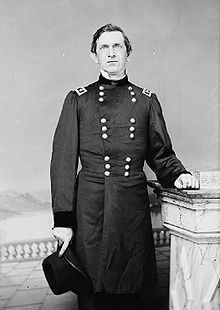Edward Canby
Edward Richard Sprigg Canby (b. November 9, 1817 at Piatt's Landing, Kentucky; † April 11, 1873 in Siskiyou County, California) was a career soldier in the United States Army with the rank of Major General.
In 1835 Canby was appointed to the Military Academy at West Point, New York and graduated in 1839 as the thirtieth of thirty-one in his class. On August 1, 1839, Canby married Louisa Hawkins at Crawfordsville, Indiana. He then fought as a lieutenant of infantry in the Second Seminole War in Florida (1839-1842), then in the war against Mexico, where he received two brevets in recognition of his service in the campaign against Mexico City.
Canby, now a major, was now transferred to staff duty, which he performed in Washington, D.C., among other places. He was then transferred to the 10th U.S. Infantry Regiment in the Trans-Mississippi Territory, where he fought under the later Confederate General Albert S. Johnston in the Utah War against the Mormons.
At the outbreak of the Civil War, Canby was appointed commander of the 19th U.S. Infantry Regiment at Fort Defiance, New Mexico Territory. In 1862, he repelled the Confederate invasion of New Mexico at the battles of Valverde, Glorieta Pass, and Peralta.
From January, 1863, to May, 1864, he was on the staff at Washington. After the Draft Riots, he assumed command of the city and port of New York for four months. In May 1864, as major general, Canby replaced Nathaniel P. Banks as commander of the military division of western Mississippi. From March to April 1865, he led the campaign against Mobile, Alabama, which ended with the capture of the city in early April. Canby also accepted the surrender of Confederate forces under General Taylor on May 4, 1865, and those under General Smith on May 26, 1865.
Promoted to brigadier general of the Regular Army, he commanded the Louisiana Military District, then the 5th Military District of Texas. In March 1869, Canby was given command by President Grant of the Military District of Columbia, where the Modoc Indians were fighting the government. On April 11, 1873, he went unarmed to parley with the Modoc leader, Captain Jack, and was murdered there along with another negotiator.
Fort Canby at the mouth of the Columbia was named after him.

Portrait of Edward Richard Sprigg Canby (c. 1860)
Search within the encyclopedia